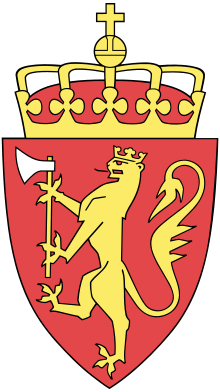Viking Age
The Viking Age (793–1066 AD) was the period during the Middle Ages when Norsemen known as Vikings undertook large-scale raiding, colonizing, conquest and trading throughout Europe, and reached North America.[1][2][3][4][5] It followed the Migration Period and the Germanic Iron Age.[6] The Viking Age applies not only to their homeland of Scandinavia, but to any place significantly settled by Scandinavians during the period.[3] The Scandinavians of the Viking Age are often referred to as Vikings as well as Norsemen, although few of them were Vikings in the technical sense.[7]
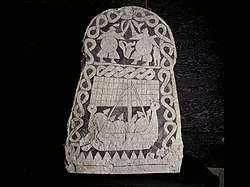
| Part of a series on |
| Scandinavia |
|---|
|
Geography |
Voyaging by sea from their homelands in Denmark, Norway and Sweden, the Norse people settled in the British Isles, Ireland, the Faroe Islands, Iceland, Greenland, Normandy, the Baltic coast, and along the Dnieper and Volga trade routes in eastern Europe (where they were known as Varangians). They also briefly settled in Newfoundland, becoming the first Europeans to reach North America. The Norse-Gaels, Normans, Rus' people, Faroese and Icelanders emerged from these Norse colonies. The Vikings founded several kingdoms and earldoms in Europe: the kingdom of the Isles (Suðreyjar), Orkney (Norðreyjar), York (Jórvík) and the Danelaw (Danalǫg), Dublin (Dyflin), Normandy, and Kievan Rus' (Garðaríki). The Norse homelands were also unified into larger kingdoms during the Viking Age, and the short-lived North Sea Empire included large swathes of Scandinavia and Britain.
Several things drove this expansion. The Vikings were drawn by the growth of wealthy towns and monasteries overseas, and weak kingdoms. They may also have been pushed to leave their homeland by overpopulation, lack of good farmland, and political strife arising from the unification of Norway. The aggressive expansion of the Carolingian Empire and forced conversion of the neighboring Saxons to Christianity may also have been a factor.[8][9][10][11][12] Sailing innovations had allowed the Vikings to sail further and longer to begin with.
Information about the Viking Age is drawn largely from primary sources written by those the Vikings encountered, as well as archaeology, supplemented with secondary sources such as the Icelandic Sagas.
Historical context
In England, the Viking attack of 8 June 793 that destroyed the abbey on Lindisfarne, a centre of learning on an island off the northeast coast of England in Northumberland, is regarded as the beginning of the Viking Age.[13][14] Monks were killed in the abbey, thrown into the sea to drown, or carried away as slaves along with the church treasures, giving rise to the traditional (but unattested) prayer—A furore Normannorum libera nos, Domine, "Free us from the fury of the Northmen, Lord."[15] Three Viking ships had beached in Weymouth Bay four years earlier (although due to a scribal error the Anglo-Saxon Chronicle dates this event to 787 rather than 789), but that incursion may have been a trading expedition that went wrong rather than a piratical raid. Lindisfarne was different. The Viking devastation of Northumbria's Holy Island was reported by the Northumbrian scholar Alcuin of York, who wrote: "Never before in Britain has such a terror appeared".[16] Vikings were portrayed as wholly violent and bloodthirsty by their enemies. In medieval English chronicles, they are described as "wolves among sheep".
The first challenges to the many anti-Viking images in Britain emerged in the 17th century. Pioneering scholarly works on the Viking Age reached a small readership in Britain. Linguistics traced the Viking Age origins of rural idioms and proverbs. New dictionaries of the Old Norse language enabled more Victorians to read the Icelandic Sagas.
In Scandinavia, the 17th-century Danish scholars Thomas Bartholin and Ole Worm and Swedish scholar Olaus Rudbeck were the first to use runic inscriptions and Icelandic Sagas as primary historical sources. During the Enlightenment and Nordic Renaissance, historians such as the Icelandic-Norwegian Thormodus Torfæus, Danish-Norwegian Ludvig Holberg, and Swedish Olof von Dalin developed a more "rational" and "pragmatic" approach to historical scholarship.
By the latter half of the 18th century, while the Icelandic sagas were still used as important historical sources, the Viking Age had again come to be regarded as a barbaric and uncivilised period in the history of the Nordic countries.
Scholars outside Scandinavia did not begin to extensively reassess the achievements of the Vikings until the 1890s, recognising their artistry, technological skills, and seamanship.[17]
Until recently, the history of the Viking Age had largely been based on Icelandic Sagas, the history of the Danes written by Saxo Grammaticus, the Kievan Rus's Primary Chronicle, and Cogad Gáedel re Gallaib. Today, most scholars take these texts as sources not to be understood literally and are relying more on concrete archaeological findings, numismatics, and other direct scientific disciplines and methods.[18][19]
Historical background

The Vikings who invaded western and eastern Europe were mainly pagans from the same area as present-day Denmark, Norway, and Sweden. They also settled in the Faroe Islands, Ireland, Iceland, peripheral Scotland (Caithness, the Hebrides and the Northern Isles), Greenland, and Canada.
Their North Germanic language, Old Norse, became the mother-tongue of present-day Scandinavian languages. By 801, a strong central authority appears to have been established in Jutland, and the Danes were beginning to look beyond their own territory for land, trade, and plunder.
In Norway, mountainous terrain and fjords formed strong natural boundaries. Communities remained independent of each other, unlike the situation in lowland Denmark. By 800, some 30 small kingdoms existed in Norway.
The sea was the easiest way of communication between the Norwegian kingdoms and the outside world. In the eighth century, Scandinavians began to build ships of war and send them on raiding expeditions which started the Viking Age. The North Sea rovers were traders, colonisers, explorers, and plunderers.
Probable causes of Norse expansion
| Part of a series on the |
| Norse people |
|---|
Extent of Norse language in 900 AD: Western Norse in red and Eastern Norse in orange. |
|
|
| WikiProject Norse history and culture |
Many theories are posited for the cause of the Viking invasions; the will to explore likely played a major role. At the time, England, Wales, and Ireland were vulnerable to attack, being divided into many different warring kingdoms in a state of internal disarray, while the Franks were well defended. Overpopulation, especially near the Scandes, was possibly influential (this theory regarding overpopulation is disputed).[20] Technological advance like the use of iron, or a shortage of women due to selective female infanticide also had an impact.[21] Tensions caused by Frankish expansion to the south of Scandinavia, and their subsequent attacks upon the Viking peoples, may have also played a role in Viking pillaging. Harald I of Norway ("Harald Fairhair") had united Norway around this time and displaced many peoples. As a result, these people sought for new bases to launch counter-raids against Harald.
Vikings would plant crops after the winter and go raiding as soon as the ice melted on the sea, then return home with their loot in time to harvest the crops.
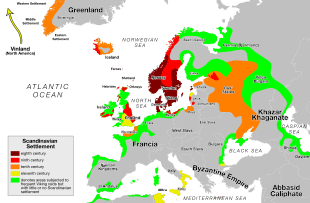
Debate among scholars is ongoing as to why the Scandinavians began to expand from the eighth through 11th centuries.
- Demographic model
- This model suggests that Scandinavia experienced a population boom just before the Viking Age began.[22] The agricultural capacity of the land was not enough to keep up with the increasing population.[23] As a result, many Scandinavians found themselves with no property and no status. To remedy this, these landless men took to piracy to obtain material wealth. The population continued to grow, and the pirates looked further and further beyond the borders of the Baltic, and eventually into all of Europe.[24]
- Economic model
- The economic model states that the Viking Age was the result of growing urbanism and trade throughout mainland Europe. As the Islamic world grew, so did its trade routes, and the wealth which moved along them was pushed further and further north.[25] In Western Europe, proto-urban centres such as the -wich town of Anglo-Saxon England began to boom during the prosperous era known as the "Long Eighth Century".[26] The Scandinavians, like many other Europeans, were drawn to these wealthier "urban" centres, which soon became frequent targets of Viking raids. The connection of the Scandinavians to larger and richer trade networks lured the Vikings into Western Europe, and soon the rest of Europe and parts of the Middle East. In England, hoards of Viking silver, such as the Cuerdale Hoard and the Vale of York Hoard, offer good insight to this phenomenon.
- Ideological model
- This era coincided with the Medieval Warm Period (800–1300) and stopped with the start of the Little Ice Age (about 1250–1850). The start of the Viking Age, with the sack of Lindisfarne, also coincided with Charlemagne's Saxon Wars, or Christian wars with pagans in Saxony. Bruno Dumézil theorises that the Viking attacks may have been in response to the spread of Christianity among pagan peoples.[9][10][11][12][27] Because of the penetration of Christianity in Scandinavia, serious conflict divided Norway for almost a century.[28]
- Political model
- The first of two main components to the political model is the external "Pull" factor, which suggests that the weak political bodies of Britain and Western Europe made for an attractive target for Viking raiders. The reasons for these weaknesses vary, but generally can be simplified into decentralized polities, or religious sites. As a result, Viking raiders found it easy to sack and then retreat from these areas which were thus frequently raided. The second case is the internal "Push" factor, which coincides with a period just before the Viking Age in which Scandinavia was undergoing a mass centralization of power in the modern-day countries of Denmark, Sweden, and especially Norway. This centralization of power forced hundreds of chieftains from their lands, which were slowly being eaten up by the kings and dynasties that began to emerge. As a result, many of these chiefs sought refuge elsewhere, and began harrying the coasts of the British Isles and Western Europe.[29]
- Technological model
- This model suggests that the Viking Age occurred as a result of technological innovations that allowed the Vikings to go on their raids in the first place.[30] There is no doubt that piracy existed in the Baltic before the Viking Age, but developments in sailing technology and practice made it possible for early Viking raiders to attack lands farther away.[31] Among these developments are included the use of larger sails, tacking practices, and 24-hour sailing.[22]
These models constitute much of what is known about the motivations for and the causes of the Viking Age. In all likelihood, the beginning of this age was the result of some combination of the aforementioned models.
Historic overview
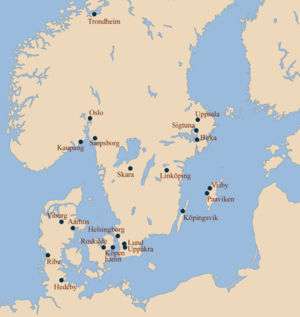
The earliest date given for a Viking raid is 789, when according to the Anglo-Saxon Chronicle, a group of Danes sailed to the Isle of Portland in Dorset (it was wrongly recorded as 787). They were mistaken for merchants by a royal official. When asked to come to the king's manor to pay a trading tax on their goods, they murdered the official.[32] The beginning of the Viking Age in the British Isles is often set at 793. It was recorded in the Anglo–Saxon Chronicle that the Northmen raided the important island monastery of Lindisfarne (the generally accepted date is actually 8 June, not January[14]):
A.D. 793. This year came dreadful fore-warnings over the land of the Northumbrians, terrifying the people most woefully: these were immense sheets of light rushing through the air, and whirlwinds, and fiery dragons flying across the firmament. These tremendous tokens were soon followed by a great famine: and not long after, on the sixth day before the ides of January in the same year, the harrowing inroads of heathen men made lamentable havoc in the church of God in Holy-island (Lindisfarne), by rapine and slaughter.
— Anglo Saxon Chronicle.[33]
In 794, according to the Annals of Ulster, a serious attack was made on Lindisfarne's mother-house of Iona, which was followed in 795 by raids upon the northern coast of Ireland. From bases there, the Norsemen attacked Iona again in 802, causing great slaughter amongst the Céli Dé Brethren, and burning the abbey to the ground.
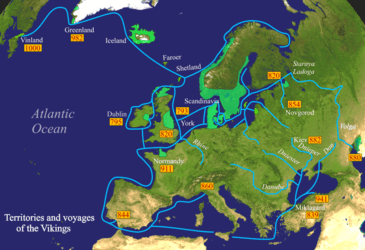
The Kingdom of the Franks under Charlemagne was particularly devastated by these raiders, who could sail up the Seine with near impunity. Near the end of Charlemagne's reign (and throughout the reigns of his sons and grandsons), a string of Norse raids began, culminating in a gradual Scandinavian conquest and settlement of the region now known as Normandy.
The clinker-built longships used by the Scandinavians were uniquely suited to both deep and shallow waters. They extended the reach of Norse raiders, traders, and settlers along coastlines and along the major river valleys of north-western Europe. Rurik also expanded to the east, and in 859 became ruler either by conquest or invitation by local people of the city of Novgorod (which means "new city") on the Volkhov River. His successors moved further, founding the early East Slavic state of Kievan Rus' with the capital in Kiev. This persisted until 1240, when the Mongols invaded Russia.
Other Norse people continued south to the Black Sea and then on to Constantinople. Whenever these Viking ships ran aground in shallow waters, the Vikings reportedly turned them on their sides and dragged them across the shallows into deeper waters. The eastern connections of these "Varangians" brought Byzantine silk, a cowrie shell from the Red Sea, and even coins from Samarkand, to Viking York.
In 884, an army of Danish Vikings was defeated at the Battle of Norditi (also called the Battle of Hilgenried Bay) on the Germanic North Sea coast by a Frisian army under Archbishop Rimbert of Bremen-Hamburg, which precipitated the complete and permanent withdrawal of the Vikings from East Frisia.
In 911, French King Charles the Simple was able to make an agreement with the Viking warleader Rollo, a chieftain of disputed Norwegian or Danish origins.[34] Charles gave Rollo the title of duke and granted his followers and him possession of Normandy. In return, Rollo swore fealty to Charles, converted to Christianity, and undertook to defend the northern region of France against the incursions of other Viking groups. Several generations later, the Norman descendants of these Viking settlers not only identified themselves as Norman, but also carried the Norman language (a Romance language with Germanic influence), and their Norman culture, into England in 1066. With the Norman Conquest, they became the ruling aristocracy of Anglo–Saxon England.
In Scandinavia, the Viking Age is considered to have ended with the establishment of royal authority in the Scandinavian countries and the establishment of Christianity as the dominant religion. The date is usually put somewhere in the early 11th century in all three Scandinavian countries. The end of the Viking era in Norway is marked by the Battle of Stiklestad in 1030. Although Olafr Haraldsson's (later known as Olav the Holy) army lost the battle, Christianity spread, partly on the strength of rumours of miraculous signs after his death. Norwegians would no longer be called Vikings. In Sweden, the reign of king Olov Skötkonung (c. 995–1020) is considered to be the transition from the Viking Age to the Middle Ages, because he was the first Christian king of the Swedes, and he is associated with a growing influence of the church in what is today southwestern and central Sweden. Norse beliefs persisted until the 12th century. Olof being the last king in Scandinavia to adopt a Christianity marked a definite end to the Viking Age.
The end of the Viking Age is traditionally marked in England by the failed invasion attempted by the Norwegian king Harald III (Haraldr Harðráði), who was defeated by Saxon King Harold Godwinson in 1066 at the Battle of Stamford Bridge; in Ireland, the capture of Dublin by Strongbow and his Hiberno-Norman forces in 1171; and 1263 in Scotland by the defeat of King Hákon Hákonarson at the Battle of Largs by troops loyal to Alexander III. Godwinson was subsequently defeated within a month by another Viking descendant, William, Duke of Normandy. Scotland took its present form when it regained territory from the Norse between the 13th and the 15th centuries; the Western Isles and the Isle of Man remained under Scandinavian authority until 1266. Orkney and Shetland belonged to the king of Norway as late as 1469.
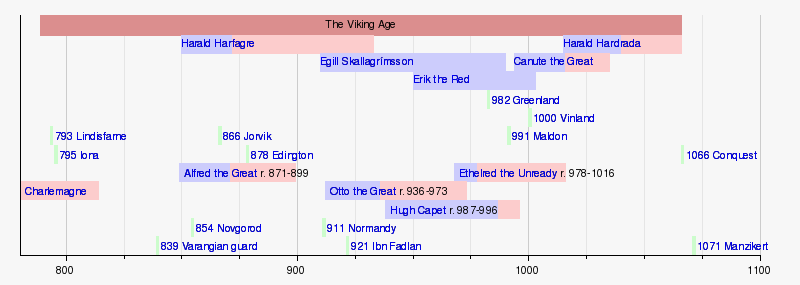
Northwestern Europe
England
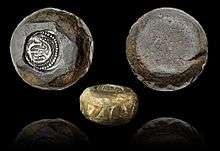
According to the Anglo-Saxon Chronicles, Viking raiders struck England in 793 and raided Lindisfarne, the monastery that held Saint Cuthbert's relics, killing the monks and capturing the valuables. The raid marked the beginning of the "Viking Age of Invasion". Great but sporadic violence continued on England's northern and eastern shores, with raids continuing on a small scale across coastal England. While the initial raiding groups were small, a great amount of planning is believed to have been involved. The Vikings raided during the winter of 840–841, rather than the usual summer, having waited on an island off Ireland. In 850, they overwintered for the first time in England, on the island of Thanet, Kent. In 854, a raiding party overwintered a second time, at the Isle of Sheppey in the Thames estuary. In 864, they reverted to Thanet for their winter encampment.[35]
The following year, the Great Heathen Army, led by brothers Ivar the Boneless (Halfdan and Ubba), and also by another Viking Guthrum, arrived in East Anglia. They proceeded to cross England into Northumbria and captured York, establishing a Viking community in Jorvik, where some settled as farmers and craftsmen. Most of the English kingdoms, being in turmoil, could not stand against the Vikings. In 867, Northumbria became the northern kingdom of the coalescing Danelaw, after its conquest by the Ragnarsson brothers, who installed an Englishman, Ecgberht, as a puppet king. By 870, the "Great Summer Army" arrived in England, led by a Viking leader called Bagsecg and his five earls. Aided by the Great Heathen Army (which had already overrun much of England from its base in Jorvik), Bagsecg's forces, and Halfdan's forces (through an alliance), the combined Viking forces raided much of England until 871, when they planned an invasion of Wessex. On 8 January 871, Bagsecg was killed at the Battle of Ashdown along with his earls. As a result, many of the Vikings returned to northern England, where Jorvic had become the centre of the Viking kingdom, but Alfred of Wessex managed to keep them out of his country. Alfred and his successors continued to drive back the Viking frontier and take York. A new wave of Vikings appeared in England in 947, when Eric Bloodaxe captured York.
In 1003, the Danish King Sweyn Forkbeard started a series of raids against England, culminating in a full-scale invasion that led to Sweyn being crowned king of England in 1013.[36][37] Sweyn was also king of Denmark and parts of Norway at this time.[38] The throne of England passed to Edmund Ironside of Wessex after Sweyn's death in 1014. Sweyn's son, Cnut the Great, won the throne of England in 1016 through conquest. When Cnut the Great died in 1035 he was a king of Denmark, England, Norway, and parts of Sweden.[39][40] Harold Harefoot became king of England after Cnut's death, and Viking rule of England ceased.
The Viking presence declined until 1066, when they lost their final battle with the English at Stamford Bridge. The death in the battle of King Harald Hardrada of Norway ended any hope of reviving Cnut's North Sea Empire, and it is because of this, rather than the Norman conquest, that 1066 is often taken as the end of the Viking Age. Nineteen days later, the Normans, themselves descendants of Norsemen, invaded England and defeated the weakened English army at the Battle of Hastings.
In 1152, Eystein II of Norway led a plundering raid down the east coast of Britain.[41]
Ireland
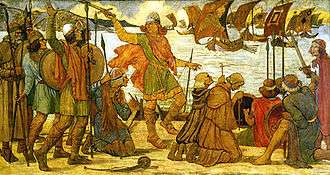
In 795, small bands of Vikings began plundering monastic settlements along the coast of Gaelic Ireland. The Annals of Ulster state that in 821 the Vikings plundered Howth and "carried off a great number of women into captivity".[42] From 840 the Vikings began building fortified encampments, longphorts, on the coast and overwintering in Ireland. The first were at Dublin and Linn Duachaill.[43] Their attacks became bigger and reached further inland, striking larger monastic settlements such as Armagh, Clonmacnoise, Glendalough, Kells and Kildare, and also plundering the ancient tombs of Brú na Bóinne.[44] Viking chief Thorgest is said to have raided the whole midlands of Ireland until he was killed by Máel Sechnaill I in 845.
In 853, Viking leader Amlaíb (Olaf) became the first king of Dublin. He ruled along with his brothers Ímar (possibly Ivar the Boneless) and Auisle.[45] Over the following decades, there was regular warfare between the Vikings and the Irish, and between two groups of Vikings: the Dubgaill and Finngaill (dark and fair foreigners). The Vikings also briefly allied with various Irish kings against their rivals. In 866, Áed Findliath burnt all Viking longphorts in the north, and they never managed to establish permanent settlements in that region.[46] The Vikings were driven from Dublin in 902.[47]
They returned in 914, now led by the Uí Ímair (House of Ivar).[48] During the next eight years the Vikings won decisive battles against the Irish, regained control of Dublin, and founded settlements at Waterford, Wexford, Cork and Limerick, which became Ireland's first large towns. They were important trading hubs, and Viking Dublin was the biggest slave port in western Europe.[49]
These Viking territories became part of the patchwork of kingdoms in Ireland. Vikings intermarried with the Irish and adopted elements of Irish culture, becoming the Norse-Gaels. Some Viking kings of Dublin also ruled the kingdom of the Isles and York; such as Sitric Cáech, Gofraid ua Ímair, Olaf Guthfrithson and Olaf Cuaran. Sigtrygg Silkbeard was "a patron of the arts, a benefactor of the church, and an economic innovator" who established Ireland's first mint, in Dublin.[50]
In 980, Máel Sechnaill Mór defeated the Dublin Vikings and forced them into submission.[51] Over the following thirty years, Brian Boru subdued the Viking territories and made himself High King of Ireland. The Dublin Vikings, together with Leinster, twice rebelled against him, but they were defeated in the battles of Glenmama (999) and Clontarf (1014). After the battle of Clontarf, the Dublin Vikings could no longer "single-handedly threaten the power of the most powerful kings of Ireland".[52] Brian's rise to power and conflict with the Vikings is chronicled in Cogad Gáedel re Gallaib ("The War of the Irish with the Foreigners").
Scotland
While few records are known, the Vikings are thought to have led their first raids in Scotland on the holy island of Iona in 794, the year following the raid on the other holy island of Lindisfarne, Northumbria.
In 839, a large Norse fleet invaded via the River Tay and River Earn, both of which were highly navigable, and reached into the heart of the Pictish kingdom of Fortriu. They defeated Eogán mac Óengusa, king of the Picts, his brother Bran, and the king of the Scots of Dál Riata, Áed mac Boanta, along with many members of the Pictish aristocracy in battle. The sophisticated kingdom that had been built fell apart, as did the Pictish leadership, which had been stable for more than 100 years since the time of Óengus mac Fergusa (The accession of Cináed mac Ailpín as king of both Picts and Scots can be attributed to the aftermath of this event).
In 870, the Britons of the Old North around the Firth of Clyde came under Viking attack as well. The fortress atop Alt Clut ("Rock of the Clyde," the Brythonic name for Dumbarton Rock, which had become the metonym for their kingdom) was besieged by the Viking kings Amlaíb and Ímar. After four months, its water supply failed, and the fortress fell. The Vikings are recorded to have transported a vast prey of British, Pictish, and English captives back to Ireland. These prisoners may have included the ruling family of Alt Clut including the king Arthgal ap Dyfnwal, who was slain the following year under uncertain circumstances. The fall of Alt Clut marked a watershed in the history of the realm. Afterwards, the capital of the restructured kingdom was relocated about 12 miles (20 km) up the River Clyde to the vicinity of Govan and Partick (within present-day Glasgow), and became known as the Kingdom of Strathclyde, which persisted as a major regional political player for another 150 years.
The land that now comprises most of the Scottish Lowlands had previously been the northernmost part of the Anglo-Saxon kingdom of Northumbria, which fell apart with its Viking conquest; these lands were never regained by the Anglo-Saxons, or England. The upheaval and pressure of Viking raiding, occupation, conquest and settlement resulted in alliances among the formerly enemy peoples that comprised what would become present-day Scotland. Over the subsequent 300 years, this Viking upheaval and pressure led to the unification of the previously contending Gaelic, Pictish, British, and English kingdoms, first into the kingdom of Alba, and finally into the greater Kingdom of Scotland.[53] The Viking Age in Scotland came to an end after another 100 years. The last vestiges of Norse power in the Scottish seas and islands were completely relinquished after another 200 years.
Earldom of Orkney
By the mid-9th century, the Norsemen had settled in Shetland, Orkney (the Nordreys- Norðreyjar), the Hebrides and Isle of Man, (the Sudreys- Suðreyjar—this survives in the Diocese of Sodor and Man) and parts of mainland Scotland. The Norse settlers were to some extent integrating with the local Gaelic population (see Norse-Gaels) in the Hebrides and Man. These areas were ruled over by local Jarls, originally captains of ships or hersirs. The Jarl of Orkney and Shetland, however, claimed supremacy.
In 875, King Harald Fairhair led a fleet from Norway to Scotland. In his attempt to unite Norway, he found that many of those opposed to his rise to power had taken refuge in the Isles. From here, they were raiding not only foreign lands but were also attacking Norway itself. He organised a fleet and was able to subdue the rebels, and in doing so brought the independent Jarls under his control, many of the rebels having fled to Iceland. He found himself ruling not only Norway, but also the Isles, Man, and parts of Scotland.
Kings of the Isles
In 876, the Norse-Gaels of Mann and the Hebrides rebelled against Harald. A fleet was sent against them led by Ketil Flatnose to regain control. On his success, Ketil was to rule the Sudreys as a vassal of King Harald. His grandson, Thorstein the Red, and Sigurd the Mighty, Jarl of Orkney, invaded Scotland and were able to exact tribute from nearly half the kingdom until their deaths in battle. Ketil declared himself King of the Isles. Ketil was eventually outlawed and, fearing the bounty on his head, fled to Iceland.
The Norse-Gaelic Kings of the Isles continued to act semi independently, in 973 forming a defensive pact with the Kings of Scotland and Strathclyde. In 1095, the King of Mann and the Isles Godred Crovan was killed by Magnus Barelegs, King of Norway. Magnus and King Edgar of Scotland agreed on a treaty. The islands would be controlled by Norway, but mainland territories would go to Scotland. The King of Norway nominally continued to be king of the Isles and Man. However, in 1156, The kingdom was split into two. The Western Isles and Man continued as to be called the "Kingdom of Man and the Isles", but the Inner Hebrides came under the influence of Somerled, a Gaelic speaker, who was styled 'King of the Hebrides'. His kingdom was to develop latterly into the Lordship of the Isles.
In eastern Aberdeenshire, the Danes invaded at least as far north as the area near Cruden Bay.[54]
The Jarls of Orkney continued to rule much of northern Scotland until 1196, when Harald Maddadsson agreed to pay tribute to William the Lion, King of Scots, for his territories on the mainland.
The end of the Viking Age proper in Scotland is generally considered to be in 1266. In 1263, King Haakon IV of Norway, in retaliation for a Scots expedition to Skye, arrived on the west coast with a fleet from Norway and Orkney. His fleet linked up with those of King Magnus of Man and King Dougal of the Hebrides. After peace talks failed, his forces met with the Scots at Largs, in Ayrshire. The battle proved indecisive, but it did ensure that the Norse were not able to mount a further attack that year. Haakon died overwintering in Orkney, and by 1266, his son Magnus the Law-mender ceded the Kingdom of Man and the Isles, with all territories on mainland Scotland to Alexander III, through the Treaty of Perth.
Orkney and Shetland continued to be ruled as autonomous Jarldoms under Norway until 1468, when King Christian I pledged them as security on the dowry of his daughter, who was betrothed to James III of Scotland. Although attempts were made during the 17th and 18th centuries to redeem Shetland, without success,[55] and Charles II ratifying the pawning in the 1669 Act for annexation of Orkney and Shetland to the Crown, explicitly exempting them from any "dissolution of His Majesty's lands",[56] they are currently considered as being officially part of the United Kingdom.[57][58]
Wales
Incursions in Wales were decisively reversed at the Battle of Buttington in Powys, 893, when a combined Welsh and Mercian army under Æthelred, Lord of the Mercians, defeated a Danish band.
Wales was not colonised by the Vikings as heavily as eastern England. The Vikings did, however, settle in the south around St. David's, Haverfordwest, and Gower, among other places. Place names such as Skokholm, Skomer, and Swansea remain as evidence of the Norse settlement.[59] The Vikings, however, did not subdue the Welsh mountain kingdoms.
Iceland
According to Sagas, Iceland was discovered by Naddodd, a Viking from the Faroe Islands, after which it was settled by mostly Norwegians fleeing the oppressive rule of Harald Fairhair (late 9th century). While harsh, the land allowed for a pastoral farming life familiar to the Norse. According to the saga of Erik the Red, when Erik was exiled from Iceland, he sailed west and pioneered Greenland.
Greenland
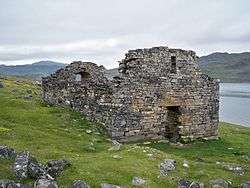
The Viking-Age settlements in Greenland were established in the sheltered fjords of the southern and western coast. They settled in three separate areas along roughly 650 km (350 nmi; 400 mi) of the western coast. While harsh, the microclimates along some fjords allowed for a pastoral lifestyle similar to that of Iceland, until the climate changed for the worse with the Little Ice Age around 1400.[60]
- The Eastern Settlement: The remains of about 450 farms have been found here. Erik the Red settled at Brattahlid on Ericsfjord.
- The Middle Settlement, near modern Ivigtut, consisted of about 20 farms.
- The Western Settlement at modern Godthåbsfjord, was established before the 12th century. It has been extensively excavated by archaeologists.
Kvenland
Kvenland, known as Cwenland, Kænland, and similar terms in medieval sources, is an ancient name for an area in Scandinavia and Fennoscandia. A contemporary reference to Kvenland is provided in an Old English account written in the 9th century. It used the information provided by the Norwegian adventurer and traveller named Ohthere. Kvenland, in that or close to that spelling, is also known from Nordic sources, primarily Icelandic, but also one that was possibly written in the modern-day area of Norway.
All the remaining Nordic sources discussing Kvenland, using that or close to that spelling, date to the 12th and 13th centuries, but some of them—in part at least—are believed to be rewrites of older texts. Other references and possible references to Kvenland by other names and/or spellings are discussed in the main article of Kvenland.
Northern Europe
Estonia
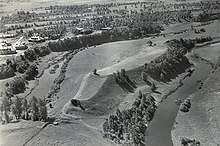
The areas of Northern and Western Estonia belonged in the Scandinavian cultural sphere during the Viking Age.[61] Estonia was not a unified country during the Viking Age, and the area of Ancient Estonia was divided among loosely allied regions.[62] The Viking Age in Estonia is often considered to be part of the Iron Age period which started around 400 AD and ended around 1200 AD, soon after Estonian Vikings were recorded in the Eric Chronicle to have sacked Sigtuna in 1187.[62]
The society, economy, settlement and culture of the territory of what is in the present-day the country of Estonia is studied mainly through archaeological sources. The era is seen to have been a period of rapid change. The Estonian peasant culture came into existence by the end of the Viking Age. The overall understanding of the Viking Age in Estonia is deemed to be fragmentary and superficial, because of the limited amount of surviving source material. The main sources for understanding the period are remains of the farms and fortresses of the era, cemeteries and a large amount of excavated objects.[63]
The landscape of Ancient Estonia featured numerous hillforts, some later hillforts on Saaremaa heavily fortified during the Viking Age and on to the 12th century.[64] There were a number of late prehistoric or medieval harbour sites on the coast of Saaremaa, but none have been found that are large enough to be international trade centres.[64] The Estonian islands also have a number of graves from the Viking Age, both individual and collective, with weapons and jewellery.[64] Weapons found in Estonian Viking Age graves are common to types found throughout Northern Europe and Scandinavia.[65]
Eastern Europe
The Varangians or Varyags (Russian, Ukrainian: варяги, varyagi; Belarusian: варагі, varahi; Greek: Βάραγγοι, Βαριάγοι, Varangoi) sometimes referred to as Variagians were Scandinavians, often Swedes, who migrated eastwards and southwards through what is now Russia, Belarus, and Ukraine mainly in the 9th and 10th centuries. Engaging in trade, piracy, and mercenary activities, they roamed the river systems and portages of Gardariki, reaching the Caspian Sea and Constantinople. Contemporary English publications also use the name "Viking" for early Varangians in some contexts.[66][67]
The term Varangian remained in usage in the Byzantine Empire until the 13th century, largely disconnected from its Scandinavian roots by then. Having settled Aldeigja (Ladoga) in the 750s, Scandinavian colonists were probably an element in the early ethnogenesis of the Rus' people, and likely played a role in the formation of the Rus' Khaganate.[68][69] The Varangians (Varyags, in Old East Slavic) are first mentioned by the Primary Chronicle as having exacted tribute from the Slavic and Finnic tribes in 859. It was the time of rapid expansion of the Vikings in Northern Europe; England began to pay Danegeld in 859, and the Curonians of Grobin faced an invasion by the Swedes at about the same date.
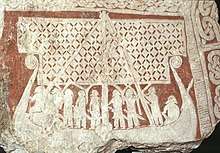
In 862, the Finnic and Slavic tribes rebelled against the Varangian Rus, driving them overseas back to Scandinavia, but soon started to conflict with each other. The disorder prompted the tribes to invite back the Varangian Rus "to come and rule them" and bring peace to the region. This was a somewhat bilateral relation with the Varagians defending the cities that they ruled. Led by Rurik and his brothers Truvor and Sineus, the invited Varangians (called Rus') settled around the town of Novgorod (Holmgard).
In the 9th century, the Rus' operated the Volga trade route, which connected Northern Russia (Gardariki) with the Middle East (Serkland). As the Volga route declined by the end of the century, the Trade route from the Varangians to the Greeks rapidly overtook it in popularity. Apart from Ladoga and Novgorod, Gnezdovo and Gotland were major centres for Varangian trade.[70]
The scholarly consensus [71] is that the Rus' people originated in what is currently coastal eastern Sweden around the eighth century and that their name has the same origin as Roslagen in Sweden (with the older name being Roden).[72][73][74] According to the prevalent theory, the name Rus', like the Proto-Finnic name for Sweden (*Ruotsi), is derived from an Old Norse term for "the men who row" (rods-) as rowing was the main method of navigating the rivers of Eastern Europe, and that it could be linked to the Swedish coastal area of Roslagen (Rus-law) or Roden, as it was known in earlier times.[75][76] The name Rus' would then have the same origin as the Finnish and Estonian names for Sweden: Ruotsi and Rootsi.[76][77]
In these years, Swedish men left to enlist in the Byzantine Varangian Guard in such numbers that a medieval Swedish law, Västgötalagen, from Västergötland declared no one could inherit while staying in "Greece"—the then Scandinavian term for the Byzantine Empire—to stop the emigration,[78] especially as two other European courts simultaneously also recruited Scandinavians:[79] Kievan Rus' c. 980–1060 and London 1018–1066 (the Þingalið).[79]
In contrast to the intense Scandinavian influence in Normandy and the British Isles, Varangian culture did not survive to a great extent in the East. Instead, the Varangian ruling classes of the two powerful city-states of Novgorod and Kiev were thoroughly Slavicised by the end of the 10th century. Old Norse was spoken in one district of Novgorod, however, until the 13th century.
Central Europe
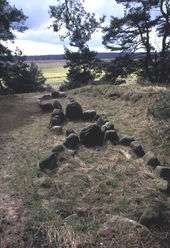
Viking Age Scandinavian settlements were set up along the southern coast of the Baltic Sea, primarily for trade purposes. Their appearance coincides with the settlement and consolidation of the Slavic tribes in the respective areas.[80] Scandinavians had contacts to the Slavs since their initial immigration, which were soon followed by both the construction of Scandinavian emporia and Slavic burghs in their vicinity.[81] The Scandinavian settlements were larger than the early Slavic ones, their craftsmen had a considerably higher productivity, and, in contrast to the early Slavs, the Scandinavians were capable of seafaring.[81] Their importance for trade with the Slavic world, however, was limited to the coastal regions and their hinterlands.[82]
Scandinavian settlements on the Mecklenburgian coast include Reric (Groß Strömkendorf) on the eastern coast of Wismar Bay,[83] and Dierkow (near Rostock).[84] Reric was set up around the year 700,[83] but following later warfare between Obodrites and Danes, the merchants were resettled to Haithabu.[84] Dierkow prospered from the late 8th to the early 9th century.[81]
Scandinavian settlements on the Pomeranian coast include Wolin (on the isle of Wolin), Ralswiek (on the isle of Rügen), Altes Lager Menzlin (on the lower Peene river),[85] and Bardy-Świelubie near modern Kołobrzeg.[86] Menzlin was set up in the mid-8th century.[83] Wolin and Ralswiek began to prosper in the course of the 9th century.[84] A merchants' settlement has also been suggested near Arkona, but no archeological evidence supports this theory.[87] Menzlin and Bardy-Świelubie were vacated in the late 9th century,[88] Ralswiek made it into the new millennium, but, by the time written chronicles reported the site in the 12th century, it had lost all its importance.[84] Wolin, thought to be identical with the legendary Vineta and the semilegendary Jomsborg, base of the Jomsvikings, was destroyed by the Danes in the 12th century.
Scandinavian arrowheads from the 8th and 9th centuries were found between the coast and the lake chains in the Mecklenburgian and Pomeranian hinterlands, pointing at periods of warfare between the Scandinavians and Slavs.[84]
Scandinavian settlements existed along the southeastern Baltic coast in Truso and Kaup (Old Prussia), and in Grobin (Courland, Latvia).
Western and Southern Europe
Frisia
In the historical context, Frisia was a region which spanned from around modern-day Bruges to the islands on the west coast of Jutland.
This region was progressively brought under Frankish control (Frisian-Frankish Wars but the Christianisation of the local population and cultural assimilation was a slow process. There is evidence that Frisians sometimes became Vikings themselves [89]
At the same time, several Frisian towns, most notably Dorestad were raided by Vikings.
On Wieringen the Vikings most likely had a base of operations.
Some Viking leaders took an active role in Frisian politics, like Godfrid, Duke of Frisia.
France
The French region of Normandy takes its name from the Viking invaders who were called Normanni, which means ‘men of the North'.
The first Viking raids began between 790 and 800 along the coasts of western France. They were carried out primarily in the summer, as the Vikings wintered in Scandinavia. Several coastal areas were lost to Francia during the reign of Louis the Pious (814–840). But the Vikings took advantage of the quarrels in the royal family caused after the death of Louis the Pious to settle their first colony in the south-west (Gascony) of the kingdom of Francia, which was more or less abandoned by the Frankish kings after their two defeats at Roncevaux. The incursions in 841 caused severe damage to Rouen and Jumièges. The Viking attackers sought to capture the treasures stored at monasteries, easy prey given the monks' lack of defensive capacity. In 845 an expedition up the Seine reached Paris. The presence of Carolingian deniers of ca 847, found in 1871 among a hoard at Mullaghboden, County Limerick, where coins were neither minted nor normally used in trade, probably represents booty from the raids of 843–846.[90]
However, from 885 to 886, Odo of Paris (Eudes de Paris) succeeded in defending Paris against Viking raiders.[91] His military success allowed him to replace the Carolingians.[92] In 911, a band of Viking warriors attempted to siege Chartres but was defeated by Robert I of France. Robert's victory later paved way for Rollo's baptism and settlement in Normandy.[93] Rollo reached an agreement with Charles the Simple to sign the Treaty of Saint-Clair-sur-Epte, under which Charles gave Rouen and the area of present-day Upper Normandy to Rollo, establishing the Duchy of Normandy. In exchange, Rollo pledged vassalage to Charles in 940, agreed to be baptised, and vowed to guard the estuaries of the Seine from further Viking attacks. During Rollo's baptism Robert I of France stood as his godfather.[94] The Duchy of Normandy also annexed further areas in Northern France, expanding the territory which was originally negotiated.
The Scandinavian expansion included Danish and Norwegian as well as Swedish elements, all under the leadership of Rollo. By the end of the reign of Richard I of Normandy in 996 (aka Richard the Fearless / Richard sans Peur), all descendants of Vikings became, according to Cambridge Medieval History (Volume 5, Chapter XV), 'not only Christians but in all essentials Frenchmen'.[95] During the Middle Ages, the Normans created one of the most powerful feudal states of Western Europe. The Normans conquered England and southern Italy in 11th century, and played a key role in the Crusades.
Italy
In 860, according to an account by the Norman monk Dudo of Saint-Quentin, a Viking fleet, probably under Björn Ironside and Hastein, landed at the Ligurian port of Luni and sacked the city. The Vikings then moved another 60 miles down the Tuscan coast to the mouth of the Arno, sacking Pisa and then, following the river upstream, also the hill-town of Fiesole above Florence, among other victories around the Mediterranean (including in Sicily and North Africa).[96]
Many Anglo-Danish and Varangian mercenaries fought in Southern Italy, including Harald Hardrada and William de Hauteville who conquered parts of Sicily between 1038 and 1040,[97][98] and Edgar the Ætheling who fought in the Norman conquest of southern Italy.[99] Runestones were raised in Sweden in memory of warriors who died in Langbarðaland (Land of the Lombards), the Old Norse name for southern Italy.[100]
Several Anglo-Danish and Norwegian nobles participated in the Norman conquest of southern Italy, like Edgar the Ætheling, who left England in 1086,[101] and Jarl Erling Skakke, who won his nickname ("Skakke", meaning bent head) after a battle against Arabs in Sicily.[102] On the other hand, many Anglo-Danish rebels fleeing William the Conqueror, joined the Byzantines in their struggle against the Robert Guiscard, duke of Apulia, in Southern Italy.[103]
Spain
After 842, when the Vikings set up a permanent base at the mouth of the Loire river, they could strike as far as northern Spain.[104] They attacked Cádiz in 844. In some of their raids they were crushed either by Asturian or Cordoban armies. These Vikings were Hispanicised in all Christian kingdoms, while they kept their ethnic identity and culture in Al-Andalus.[105]
In 1015, a Viking fleet entered the river Minho and sacked the episcopal city of Tui (Galicia); no new bishop was appointed until 1070.[106]
Portugal
In 844, many dozens of drakkars appeared in the "Mar da Palha" ("the Sea of Straw", mouth of the Tagus river). After a siege, the Vikings conquered Lisbon (at the time, the city was under Muslim rule and known as Lashbuna). They left after 13 days, following a resistance led by Alah Ibn Hazm and the city's inhabitants. Another raid was attempted in 966, without success.
North America
In about 986, the Norwegian Vikings Bjarni Herjólfsson, Leif Ericson and Þórfinnr Karlsefni from Greenland reached North America, over 500 years before Christopher Columbus, and they attempted to settle the land they called Vinland. They created a small settlement on the northern peninsula of present-day Newfoundland, near L'Anse aux Meadows. Conflict with indigenous peoples and lack of support from Greenland brought the Vinland colony to an end within a few years. The archaeological remains are now a UNESCO World Heritage Site.[107]
Technology
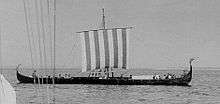
The Vikings were equipped with the technologically superior longships; for purposes of conducting trade however, another type of ship, the knarr, wider and deeper in draft, were customarily used. The Vikings were competent sailors, adept in land warfare as well as at sea, and they often struck at accessible and poorly defended targets, usually with near impunity. The effectiveness of these tactics earned Vikings a formidable reputation as raiders and pirates.
The Vikings used their longships to travel vast distances and attain certain tactical advantages in battle. They could perform highly efficient hit-and-run attacks, in which they quickly approached a target, then left as rapidly as possible before a counter-offensive could be launched. Because of the ships' negligible draft, the Vikings could sail in shallow waters, allowing them to invade far inland along rivers. The ships were agile, and light enough to be carried over land from one river system to another. "Under sail, the same boats could tackle open water and cross the unexplored wastes of the North Atlantic."[108] The ships' speed was also prodigious for the time, estimated at a maximum of 14–15 knots (26–28 km/h). The use of the longships ended when technology changed, and ships began to be constructed using saws instead of axes, resulting in inferior vessels.
While battles at sea were rare, they would occasionally occur when Viking ships attempted to board European merchant vessels in Scandinavian waters. When larger scale battles ensued, Viking crews would rope together all nearby ships and slowly proceed towards the enemy targets. While advancing, the warriors hurled spears, arrows, and other projectiles at the opponents. When the ships were sufficiently close, melee combat would ensue using axes, swords, and spears until the enemy ship could be easily boarded. The roping technique allowed Viking crews to remain strong in numbers and act as a unit, but this uniformity also created problems. A Viking ship in the line could not retreat or pursue hostiles without breaking the formation and cutting the ropes, which weakened the overall Viking fleet and was a burdensome task to perform in the heat of battle. In general, these tactics enabled Vikings to quickly destroy the meagre opposition posted during raids.[109]
Together with an increasing centralisation of government in the Scandinavian countries, the old system of leidang — a fleet mobilisation system, where every skipreide (ship community) had to maintain one ship and a crew — was discontinued as a purely military institution, as the duty to build and man a ship soon was converted into a tax. The Norwegian leidang was called under Haakon Haakonson for his 1263 expedition to Scotland during the Scottish–Norwegian War, and the last recorded calling of it was in 1603. However, already by the 11th and 12th centuries, European fighting ships were built with raised platforms fore and aft, from which archers could shoot down into the relatively low longships. This led to the defeat of longship navies in most subsequent naval engagements—e.g., with the Hanseatic League.
Exactly how the Vikings navigated the open seas with such success is unclear. While some evidence points to the use of calcite "sunstones" to find the sun's location, modern reproductions of Viking "sky-polarimetric" navigation have found these sun compasses to be highly inaccurate, and not usable in cloudy or foggy weather.[110][111]
The archaeological find known as the Visby lenses from the Swedish island of Gotland may be components of a telescope. It appears to date from long before the invention of the telescope in the 17th century.[112] Recent evidence suggests that the Vikings also made use of an optical compass as a navigation aid, using the light-splitting and polarisation-filtering properties of Iceland spar to find the location of the sun when it was not directly visible.[113]
Religion
Trade centres
Some of the most important trading ports founded by the Norse during the period include both existing and former cities such as Aarhus (Denmark), Ribe (Denmark), Hedeby (Germany), Vineta (Pomerania), Truso (Poland), Bjørgvin (Norway), Kaupang (Norway), Skiringssal (Norway), Birka (Sweden), Bordeaux (France), York (England), Dublin (Ireland) and Aldeigjuborg (Russia).
One important centre of trade was at Hedeby. Close to the border with the Franks, it was effectively a crossroads between the cultures, until its eventual destruction by the Norwegians in an internecine dispute around 1050. York was the centre of the kingdom of Jórvík from 866, and discoveries there (e.g., a silk cap, a counterfeit of a coin from Samarkand and a cowry shell from the Red Sea or the Persian Gulf) suggest that Scandinavian trade connections in the 10th century reached beyond Byzantium. However, those items could also have been Byzantine imports, and there is no reason to assume that the Varangians travelled significantly beyond Byzantium and the Caspian Sea.
Genetics
A genetic study published at bioRxiv in July 2019 examined the population genomics of the Viking Age. 442 ancient humans from across Europe and the North Atlantic were surveyed, stretching from the Bronze Age to the Early Modern Period. It was found that there was a notable foreign gene flow into Scandinavia in the years preceding the Viking Age and during the Viking Age itself. This gene flow entered Denmark and eastern Sweden, from which it spread into the rest of Scandinavia. The study also found that despite close cultural similarities, there were distinct genetic differences between regional populations in the Viking Age. These differences have persisted into modern times. Inland areas were found to be more genetically homogenous than coastal areas and islands such as Öland and Gotland. These islands were probably important trade settlements. The Vikings were found to have left a profound genetic imprint in the areas they settled, which has persisted into modern times. The genetic data from these areas affirmed conclusions previously drawn from historical and archaeological evidence.[114]
Legacy
Scandinavia
During, and as a result of the Viking Age, Scandinavia moved from a loose coexistence of tribes and petty kingdoms to the three Nordic countries that still exist today.
Settlements outside Scandinavia
British Isles
Ireland
Isle of Man
Scotland
Western Europe
Eastern Europe
- Garðaríki (Russia)
Northern Europe
Atlantic
North America
- Norse colonisation of the Americas
- L'Anse aux Meadows (and possibly a larger area called Vinland)
Old Norse influence on the English language
The long-term linguistic effect of the Viking settlements in England was threefold: over a thousand Old Norse words eventually became part of Standard English; numerous places in the East and North-east of England have Danish names, and many English personal names are of Scandinavian origin.[116] Scandinavian words that entered the English language included landing, score, beck, fellow, take, busting and steersman.[116] The vast majority of loan words did not appear in documents until the early 12th century; these included many modern words which used sk- sounds, such as skirt, sky, and skin; other words appearing in written sources at this time included again, awkward, birth, cake, dregs, fog, freckles, gasp, law, moss, neck, ransack, root, scowl, sister, seat, sly, smile, want, weak and window from Old Norse meaning "wind-eye".[116] Some of the words that came into use are among the most common in English, such as to go, to come, to sit, to listen, to eat, both, same, get and give. The system of personal pronouns was affected, with they, them and their replacing the earlier forms. Old Norse influenced the verb to be; the replacement of sindon by are is almost certainly Scandinavian in origin, as is the third-person-singular ending -s in the present tense of verbs.[116]
There are more than 1,500 Scandinavian place names in England, mainly in Yorkshire and Lincolnshire (within the former boundaries of the Danelaw): over 600 end in -by, the Scandinavian word for "village"—for example Grimsby, Naseby and Whitby;[117] many others end in -thorpe ("farm"), -thwaite ("clearing"), and -toft ("homestead").[116]
The distribution of family names showing Scandinavian influence is still, as an analysis of names ending in -son reveals, concentrated in the north and east, corresponding to areas of former Viking settlement. Early medieval records indicate that over 60% of personal names in Yorkshire and North Lincolnshire showed Scandinavian influence.[116]
Notes
- Mawer, Allen (1913). The Vikings. Cambridge University Press. p. 1. ISBN 095173394X.
The term ' Viking ' is derived from the Old Norse vik, a bay, and means 6 one who haunts a bay, creek or fjord 1 '. In the 9th and 10th centuries it came to be used more especially of those warriors who left their homes in Scandinavia and made raids on the chief European countries. This is the narrow, and technically the only correct use of the term 6 Viking/ but in such expressions as 6 Viking civilisation/ 6 the Viking Age/ 'the Viking movement/ 'Viking in- fluence/ the word has come to have a wider significance and is used as a concise and convenient term for describing the whole of the civilisation, activity and influence of the Scandinavian peoples, at a particular period in their history...
- Sawyer, Peter H. (1995). Scandinavians and the English in the Viking Age. University of Cambridge. p. 3. ISBN 095173394X.
The Viking period is, therefore, best defined as the period when Scandinavians played a large role in the British Isles and western Europe as raiders and conquerors. It is also the period in which Scandinavians settled in many of the areas they conquered, and in the Atlantic islands...
- Jesch, Judith (1991). Women in the Viking Age. Boydell & Brewer Ltd. p. 84. ISBN 0851153607.
International contact is the key to the Viking Age. In Scandinavian history this period is distinct because large numbers of Scandinavian people left their homelands and voyaged abroad... The period is thus defined by the impact the Scandinavians had on the world around them.
- Silberman, Neil Asher (2012). The Oxford Companion to Archaeology. OUP USA. p. 87. ISBN 978-0199735785.
The “Viking Age” is traditionally defined as the period when Scandinavian raiders terrorized Europe
- See Vikingertiden in (Keary, Charles Francis (1911). . In Chisholm, Hugh (ed.). Encyclopædia Britannica. 28 (11th ed.). Cambridge University Press. p. 68.) }}
- Forte, p. 2
-
- Haywood, John (1995). The Penguin Historical Atlas of the Vikings. Penguin Books. p. 8. ISBN 0140513280.
The term "Viking" has come to be applied to all Scandinavians of the period, but in the Viking Age itself the term vikingr applied only to someone who went i viking, that is plundering. In this sense, most Viking-age Scandinavians were not Vikings at all, but peaceful farmers and craftsmen who stayed quietly at home all their lives."
- Haywood, John (1999). The Vikings. Sutton. p. 37. ISBN 0750921943.
The term 'Viking' has come in modern times to be applied to all early medieval Scandinavians and it is directly as a result of this that the controversy has arisen. As used originally in the Viking Age itself, the word was applied only to someone who went i viking, that is someone whose occupation was piracy. The earliest use of the word predates the Viking Age by some years and it was not even used exclusively to describe Scandinavian pirates. Most Viking Age Scandinavians were not Vikings at all in this original sense of the word but were simply peaceful farmers, craftsmen and merchants."
- Wilson, David M. (2008). The Vikings in the Isle of Man. Aarhus University Press. p. 11. ISBN 978-8779343672.
One of the problems facing any serious writer dealing with the Viking Age concerns the usage of the term 'Viking' itself, which I have used – if sparingly – in much of this book. The word 'Viking' did not come into general use in the English language until the middle of the nineteenth Century – at about the same time that it was introduced into serious academic literature in Scandinavia – and has since then changed its meaning and been much abused. It must, however, be accepted that the term is today used throughout the world as a descriptor of the peoples of Scandinavia in the period from the late eighth Century until the mid-eleventh Century. To the general public, however, it has apparently two meanings; both are respectable and hallowed in the English language by two centuries of usage. The first is in the sense of 'raider' or 'pirate', the second in the sense of the activities of the Scandinavians outside their own country in that period. It is the latter meaning that has given rise to the useful term 'the Viking Age'. Disregarding the ultimate philology of the word and the history of its use over the centuries, which has been much discussed, it is now in such everyday use by both specialists and non-specialists – however improperly – to describe the Scandinavians of the Viking Age, that it almost impossible to avoid its use in this generic sense. Although it is often appropriate and necessary to use such terms as 'Scandinavian' or 'Norse', as I have done in this book, it is often simpler and less confusing to label something as 'Viking' rather than deal in scholastic circumlocution to placate purists, however justified they may be in their arguments."
- Rogers, Clifford J., ed. (2010). "Vikings". The Oxford Encyclopedia of Medieval Warfare and Military Technology. Oxford University Press. ISBN 9780195338423. Retrieved 3 January 2020.
“Vikings” is the usual generic term given today to all Scandinavians of the Viking Age
- Haywood, John (1995). The Penguin Historical Atlas of the Vikings. Penguin Books. p. 8. ISBN 0140513280.
- Simek, Rudolf (2005) "the emergence of the viking age: circumstances and conditions", "The vikings first Europeans VIII – XI century – the new discoveries of archaeology", other, pp. 24–25
- Bruno Dumézil, master of Conference at Paris X–Nanterre, Normalien, aggregated history, author of conversion and freedom in the barbarian kingdoms. 5th – 8th centuries (Fayard, 2005)
- "Franques Royal Annals" cited in Sawyer, Peter (2001) The Oxford Illustrated History of the Vikings. ISBN 0-19-285434-8. p. 20
- Decaux, Alain and Castelot, André (1981) Dictionnaire d'histoire de France. Perrin. ISBN 2-7242-3080-9. pp. 184–85
- Boyer, R. (2008) Les Vikings: histoire, mythes, dictionnaire. R. Laffont. ISBN 978-2-221-10631-0. p. 96
- "History of Lindisfarne Priory". English Heritage. Archived from the original on 7 March 2016. Retrieved 3 March 2016.
- Swanton, Michael (1998). The Anglo-Saxon Chronicle. Psychology Press. ISBN 0-415-92129-5. p. 57, n. 15.
- Albert D'Haenens, Les Invasions Normandes en Belgique au IX Siecle (Louvain 1967) asserts that the phrase cannot be documented. It is asserted that the closest documented phrase is a sentence from an antiphon for churches dedicated to St. Vaast or St. Medard: Summa pia gratia nostra conservando corpora et cutodita, de gente fera Normannica nos libera, quae nostra vastat, Deus, regna, "Our supreme and holy Grace, protecting us and ours, deliver us, God, from the savage race of Northmen which lays waste our realms." Magnus Magnusson, Vikings! (New York: E.P. Dutton 1980), ISBN 0-525-22892-6, p. 61.
- Jones, p. 195. Simeon of Durham recorded the raid in these terms:
And they came to the church of Lindisfarne, laid everything waste with grievous plundering, trampled the holy places with polluted feet, dug up the altars, and seized all the treasures of the holy church. They killed some of the brothers; some they took away with them in fetters; many they drove out, naked and loaded with insults; and some they drowned in the sea."
Magnus Magnusson, Vikings!, p. 32. - Palmer, Alan Warwick (2006). Northern Shores: a history of the Baltic Sea and its peoples. London: John Murray. p. 21. ISBN 978-0-7195-6299-0. OCLC 63398802.
- Sawyer, Peter Hayes (1997). The Oxford Illustrated History of the Vikings. Oxford University Press. ISBN 978-0-19-820526-5. Retrieved 17 October 2015.
- Jones, pp. 8–10
- "One of the most popular explanations offered for the Viking phenomenon is that overpopulation created a need for more land—especially in mountainous Norway—and thus the Vikings were largely motivated by a desire to colonise. Peter Sawyer, for example, in 1971, said that the first raids on Britain, by the Norwegians, were a byproduct of the colonisation of the Orkneys and the Shetlands, and that the Norwegians were more interested in settlement than in plunder. More recently, however, a couple of problems have emerged with this explanation. For a start, Sawyer in 1982 reneged somewhat by saying that no good evidence exists for any population pressure in the eighth century. Patrick Wormald added that what has been taken for overpopulation was just population concentration due to economic expansion and the mining of iron ore. In a further point, Wormald states that no clear evidence has been found for any Viking settlement until the mid-9th century, some 50–60 years after the raids began. Thus, colonisation seems to have been a secondary feature of Viking activity; the success of the raids opened the way for settlement, but were not motivated by it, at least not initially."The Vikings – Why They Did It, from the edited h2g2, the Unconventional Guide to Life, the Universe and Everything" Archived 18 May 2015 at the Wayback Machine (3 July 2000). See also P.H. Sawyer, "The Causes of the Viking Age" in The Vikings (R.T. Farrell, ed. 1982), London: Phillimore & Co, pp. 1–7; P.H. Sawyer, The Age of the Vikings (2nd Ed. 1971), London: Edward Arnold). "It has been suggested that the expansion of the Viking Age was spurred by a population growth outstepping the capacities of domestic resources. Archaeological evidence shows that new farms were cleared in sparsely populated forest areas at the time of the foreign expansion—so the pressure of population growth is surely a contributing factor." Arne Emil Christensen Archived 4 March 2016 at the Wayback Machine, The Vikings.
- Wicker, Nancy (1998). Hallsal, Guy (ed.). Selective female infanticide as partial explanation for dearth of women in Viking Age Scandinavia. Woodbridge: Boydell press. pp. 205–21. ISBN 978-0-85115-713-9.
- Barrett, James H. What Caused the Viking Age? Antiquity 82.317 (2008): 671–85. Web., 673
- Ferguson, Robert. The Vikings: A History. New York: Viking, 2009. Print., 45
- Fletcher, Richard. Roman–Britain and Anglo–Saxon England 55 BC–AD 1066. Mechanicsburg, 2002., 177
- Ferguson, Robert. The Vikings: A History. New York: Viking, 2009. Print., 48
- Hansen, I.L & C. Wickham. The Long Eighth Century: Production, Distribution, and Demand. Leiden: Brill, 2000.
- François-Xavier Dillmann, "Viking civilisation and culture. A bibliography of French-language", Caen, Centre for research on the countries of the North and Northwest, University of Caen, 1975, p. 19, and" Les Vikings – the Scandinavian and European 800–1200 ", 22nd exhibition of art from the Council of Europe, 1992, p. 26
- Sturlusson, Snorri (2000) History of the Kings of Norway. Gallimard. ISBN 2-07-073211-8 pp. 15–16, 18, 24, 33–34, 38
- Barrett, James H. What Caused the Viking Age? Antiquity 82.317 (2008): 671–85 [678–79]
- Ferguson, Robert. The Vikings: A History. New York: Viking, 2009. Print., 58
- Pearson, Andrew. Piracy in Late Roman Britain: A Perspective from the Viking Age. Britannia 37 (2006): Web.
- "The Vikings 787 AD–1066 AD (Anglo Saxon Britain)". Ports & ships. Archived from the original on 15 July 2011.
- "The Anglo-Saxon Chronicle: Part 2". Medieval and Classical Literature Library. Archived from the original on 13 April 2018. Retrieved 7 June 2011.
- The material suggesting a Norwegian origin identifies him with Hrolf the Ganger, also known as "Rolf the Walker"
- Hall, p. 13
- Sweyn (r. 1013–1014), The Official Website Of The British Monarchy, archived from the original on 29 November 2014, retrieved 16 November 2014
- Badsey, S. Nicolle, D, Turnbull, S (1999). "The Timechart of Military History". Worth Press Ltd, 2000, ISBN 1-903025-00-1.
- Lund, Niels (2001). "The Danish Empire and the End of the Viking Age", pp. 167–81 in The Oxford Illustrated History of the Vikings. Ed. P.H. Sawyer. Oxford University Press. ISBN 0-19-285434-8.
- Canute 'The Great' (r. 1016–1035), The Official Website Of The British Monarchy, archived from the original on 29 November 2014, retrieved 16 November 2014
- Lawson, M.K. (2004). "Cnut: England's Viking King 1016–35". The History Press Ltd. ISBN 978-0-582-05970-2.
- Forte, p. 216
- Andrea Dolfini; Rachel J. Crellin; Christian Horn; Marion Uckelmann (2018). Prehistoric Warfare and Violence: Quantitative and Qualitative Approaches. Springer. p. 349. ISBN 978-3-319-78828-9.
- Ó Corráin, Donnchadh (2001), "The Vikings in Ireland", in Larsen, Anne-Christine (ed.), The Vikings in Ireland. The Viking Ship Museum, p.19
- Ó Cróinín, Dáibhí. Early Medieval Ireland 400-1200. Taylor & Francis, 2016 . p.267
- Ó Corráin, "The Vikings in Ireland", p. 28–29.
- Ó Corráin, "The Vikings in Ireland", p.20.
- Downham, Clare (2007). Viking Kings of Britain and Ireland: The Dynasty of Ívarr to A.D. 1014. Dunedin Academic Press. p. 26. ISBN 978-1-903765-89-0.
- Ó Corráin, "The Vikings in Ireland", p.22.
- Gorski, Richard. Roles of the Sea in Medieval England. Boydell Press, 2012 .p.149
- Hudson, Benjamin T. "Sihtric (Sigtryggr Óláfsson, Sigtryggr Silkiskegg) (d. 1042)". Oxford Dictionary of National Biography (online ed.). Oxford University Press. doi:10.1093/ref:odnb/25545. (Subscription or UK public library membership required.)
- Downham, Viking Kings of Britain and Ireland, pp. 51–52
- Downham, Viking Kings of Britain and Ireland, p.61
- The Makers of Scotland: Picts, Romans, Gaels and Vikings, by Tim Clarkson, Birlinn Ltd, Edinburgh, 2013."
- Hogan, C. Michael (2008) "'Catto Long Barrow fieldnotes" Archived 18 January 2009 at the Wayback Machine. The Modern Antiquarian
- "Norsken som døde" Archived 24 July 2011 at the Wayback Machine. Universitas – Kultur onsdag. 9 October 1996
- 1669 Act for annexation of Orkney and Shetland to the Crown Archived 18 May 2011 at the Wayback Machine. Shetland & Orkney Udal Law group
- History and Heritage. Shetland Tourism
- "Shetland Islands Council – Ports and Harbours" Archived 14 September 2010 at the Wayback Machine. shetland.gov.uk.
- Williams, John Garnons. Wales at the Time of the Treaty of Montgomery in 1267. Mapping Medieval Wales. gwp.enta.net
- see also History of Greenland#Norse failure.
- Tvauri 2012, p. 322.
- Frucht 2004.
- Tvauri 2012.
- Mägi 2015, pp. 45–46.
- Martens 2004, pp. 132–35.
- "Oleg". Encyclopædia Britannica. Archived from the original on 11 October 2007. Retrieved 3 August 2007.
- "Rurik". Encyclopædia Britannica. Archived from the original on 30 September 2007. Retrieved 3 August 2007.
- Land of the Rus – Viking expeditions to the east Archived 28 February 2014 at the Wayback Machine National Museum of Denmark
- Dangerous journeys to Eastern Europe and Russia Archived 28 February 2014 at the Wayback Machine National Museum of Denmark
- A massive majority (40,000) of all Viking Age Arabian coins found in Scandinavia were found in Gotland. In Skåne, Öland and Uppland together, about 12,000 coins were found. Other Scandinavian areas have only scattered finds: 1,000 from Denmark and some 500 from Norway. Byzantine coins have been found almost exclusively in Gotland, some 400.
See:
Burenhult, Göran (1999). Arkeologi i Norden 2 [Archeology in the Nordic countries, part 2] (in Swedish). Stockholm: Natur & Kultur. ISBN 978-91-27-13478-2.
See also:
Gardell, Carl Johan (1987). Gotlands historia i fickformat [The pocket history of Gotland] (in Swedish). ISBN 978-91-7810-885-5. - "The Vikings at home". HistoryExtra.
- "Kievan Rus". Ancient History Encyclopedia.
- https://www.metmuseum.org/toah/hd/vikg/hd_vikg.htm
- "Viking Tours Stockholm, 20 Historical Cultural Transported Tours". Sweden History Tours.
- Blöndal, Sigfús (1978). The Varangians of Byzantium. Cambridge University Press. p. 1. ISBN 9780521035521. Retrieved 2 February 2014.
- Stefan Brink, 'Who were the Vikings?', in The Viking World, ed. by Stefan Brink and Neil Price (Abingdon: Routledge, 2008), pp. 4-10 (pp. 6-7).
- "Russ, adj. and n." OED Online, Oxford University Press, June 2018, www.oed.com/view/Entry/169069. Accessed 25 July 2018.
- Jansson 1980:22
- Pritsak 1981:386
- Harck, p. 17
- Harck, p. 15
- Harck, pp. 16–17
- Harck, p. 12
- Harck, p. 18
- Herrmann, Joachim (1985) Die Slawen in Deutschland. Akademie-Verlag Berlin. pp. 237ff, 244ff
- Harck, pp. 15–16
- Harck, p. 13
- Harck, p. 16
- Twenthieth Landlaw of the Frisians (late 10th-early 11th C.) and K. Samplonius, It Beaken 60:2
- Hall, p. 17
- "Odo of West Francia". Ancient History Encyclopaedia.
- "Globetrotting Vikings: To the Gates of Paris". History Channel.
- "Robert I of France". Encyclopaedia Britannica.
- "Robert 1 of France". Britannica Encyclopaedia.
- Tanner, J.R.; Previte-Orton, C.W.; Brook, Z.N. Cambridge Medieval History (Volume 5, Chapter XV). Cambridge University Press.
- Haywood, John (8 October 2015). Northmen. Head of Zeus.
- Carr, John (30 April 2015). Fighting Emperors of Byzantium. Pen and Sword. p. 177.
- Hill, Paul (30 June 2015). The Norman Commanders: Masters of Warfare 911–1135. Pen and Sword. p. 18.
- Anglo-Saxon Chronicles, p. 217; Florence of Worcester, p. 145
- 2. Runriket – Täby Kyrka Archived 4 June 2008 at the Wayback Machine, an online article at Stockholm County Museum, retrieved 1 July 2007.
- Anglo-Saxon Chronicles, p. 217; Florence of Worcester, p. 145
- Orkneyinga Saga, Anderson, Joseph, (Edinburgh: Edmonston and Douglas, 1873), FHL microfilm 253063., p. 134, 139, 144-145, 149-151, 163, 193.
- Translation based on Chibnall (ed.), Ecclesiastical History, vol. ii, pp. 203, 205
- Forte, p. 60
- "Los vikingos en Al-Andalus (abstract available in English)" (PDF). Jesús Riosalido. 1997. Archived from the original (PDF) on 18 July 2011. Retrieved 11 May 2010.
- Fletcher, Richard A. (1997) The conversion of Europe: from paganism to Christianity 371–1386 AD. HarperCollins. ISBN 0-00-255203-5. p. 370
- UNESCO World Heritage Centre. "L’Anse aux Meadows National Historic Site" Archived 16 June 2006 at the Wayback Machine. unesco.org.
- Tignor, Robert; Adelman, Jeremy; Brown, Peter; Elman, Benjamin; Kotkin, Stephen; Prakash, Gyan; Shaw, Brent; Aron, Stephen; Liu, Xinru; Marchand, Suzanne; Pittman, Holly; Tsin, Michael. Worlds Together, Worlds Apart: A History of the World: Beginnings Through the Fifteenth Century (Fourth Edition) (Vol. 1) (Page 352). W.W. Norton & Company. Kindle Edition.
- Foote, P. and Wilson, D.M. (1970)The Viking Achievement. Sidgwick & Jackson Ltd. ISBN 0-283-35499-2. pp. 282–85.
- Horvàth, G. et al. (2011). 'On the trail of Vikings with polarized skylight: experimental study of the atmospheric optical prerequisites allowing polarimetric navigation by Viking seafarers' Phil. Trans. R. Soc. B (2011) 366, 772–82 doi:10.1098/rstb.2010.0194
- Farkas, Alexandra; Szaz, Denes; Egri, Adam; Blahó, Miklós; Barta, András; Tarczay-Nehéz, Dóra; Bernáth, Balázs; Horváth, Gábor (30 June 2014). "Accuracy of sun localization in the second step of sky-polarimetric Viking navigation for north determination: A planetarium experiment". Journal of the Optical Society of America A. 31 (7): 1645–56. Bibcode:2014JOSAA..31.1645F. doi:10.1364/JOSAA.31.001645. PMID 25121454.
- Did the Vikings make a telescope? Archived 25 April 2006 at the Wayback Machine BBC. 5 April 2000
- "AFP: Viking 'sunstone' more than a myth". 1 November 2011. Archived from the original on 20 June 2013. Retrieved 15 April 2013.
- Margaryan 2019.
- Oxford Dictionary of British Place Names
- Crystal, David, The Cambridge Encyclopedia of the English Language, CUP, 2001 edition, ISBN 0-521-59655-6, pp. 25–26.
- "The -by ending is almost entirely confined to the area of the Danelaw, supporting a theory of Scandinavian origin, despite the existence of the word by "dwelling" in Old English." Crystal, p 25.
Cited sources
- Forte, Angelo; Oram, Richard; Pedersen, Frederik (2005). Viking Empires. Cambridge University Press. ISBN 978-0-521-82992-2.
- Hall, Richard (2010). Viking Age archaeology. Shire Publications. ISBN 978-0-7478-0063-7.
- Harck, Ole; Lübke, Christian (2001). Zwischen Reric und Bornhöved: Die Beziehungen zwischen den Dänen und ihren slawischen Nachbarn vom 9. Bis ins 13. International Conference, Leipzig, 4–6 December 1997, Franz Steiner Verlag. ISBN 978-3-515-07671-5.
- Jones, Gwyn (1968). A History of the Vikings. Oxford University Press. OCLC 581030305.
- Margaryan, Ashot (17 July 2019). "Population genomics of the Viking world". bioRxiv 10.1101/703405. doi:10.1101/703405v1.full (inactive 24 January 2020). Retrieved 16 January 2020. Cite journal requires
|journal=(help)
Further reading
Background
- Brink, S. with Price, N. (eds) (2008). The Viking World, [Routledge Worlds], Routledge: London and New York, 2008. ISBN 978-0-415-69262-5
- Graham-Campbell, J. (2001), The Viking World, London, 2001. ISBN 978-0-7112-3468-0
General surveys
- Ahola, Joonas & Frog with Clive Tolley (eds.) (2014). Fibula, Fabula, Fact – The Viking Age in Finland. Studia Fennica Historica 18. Helsinki: Finnish Literature Society.
- Anker, P. (1970). The Art of Scandinavia, Volume I, London and New York, 1970.
- Fuglesang, S.H. (1996). "Viking Art", in Turner, J. (ed.), The Grove Dictionary of Art, Volume 32, London and New York, 1996, pp. 514–27, 531–32.
- Graham-Campbell, J. (1980). Viking Artefacts: A Select Catalogue, British Museum Publications: London, 1980. ISBN 978-0-7141-1354-8
- Graham-Campbell, James (2013). Viking Art, Thames & Hudson, 2013. ISBN 978-0-500-20419-1
- Roesdahl, E. and Wilson, D.M. (eds) (1992). From Viking to Crusader: Scandinavia and Europe 800–1200, Copenhagen and New York, 1992. [exhibition catalogue]. ISBN 978-0-8478-1625-5
- Williams, G., Pentz, P. and Wemhoff, M. (eds), Vikings: Life and Legend, British Museum Press: London, 2014. [exhibition catalogue]. ISBN 978-0-7141-2336-3
- Wilson, D.M. & Klindt-Jensen, O. (1980). Viking Art, second edition, George Allen and Unwin, 1980. ISBN 978-0-04-709018-9
- Carey, Brian Todd. "Technical marvels, Viking longships sailed seas and rivers, or served as floating battlefields", Military History 19, no. 6 (2003): 70–72.
- Downham, Clare. Viking Kings of Britain and Ireland: The Dynasty of Ívarr to A.D. 1014. Edinburgh: Dunedin Academic Press, 2007
- Hudson, Benjamin. Viking Pirates and Christian Princes: Dynasty, Religion, and Empire in the North Atlantic. Oxford: Oxford University Press, 2005 ISBN 0-19-516237-4.
- Logan, F. Donald The Vikings in History (London: Hutchison & Co. 1983) ISBN 0-415-08396-6.
- Maier, Bernhard. The Celts: A history from earliest times to the present. Notre Dame, Indiana: University of Notre Dame Press, 2003.
External links
| Wikimedia Commons has media related to Viking Age. |
- Vikings – BBC History (collection of short articles under the headings Overview, Raiders and Settlers, Viking Culture, Evidence)
- Vikings: The North Atlantic Saga – Smithsonian website for travelling exhibition, 2000–2003.
- The Danish Viking Age
- Old Norse literature from «Kulturformidlingen norrøne tekster og kvad» Norway.
- ScienceNordic's article on "How Vikings navigated the world"

